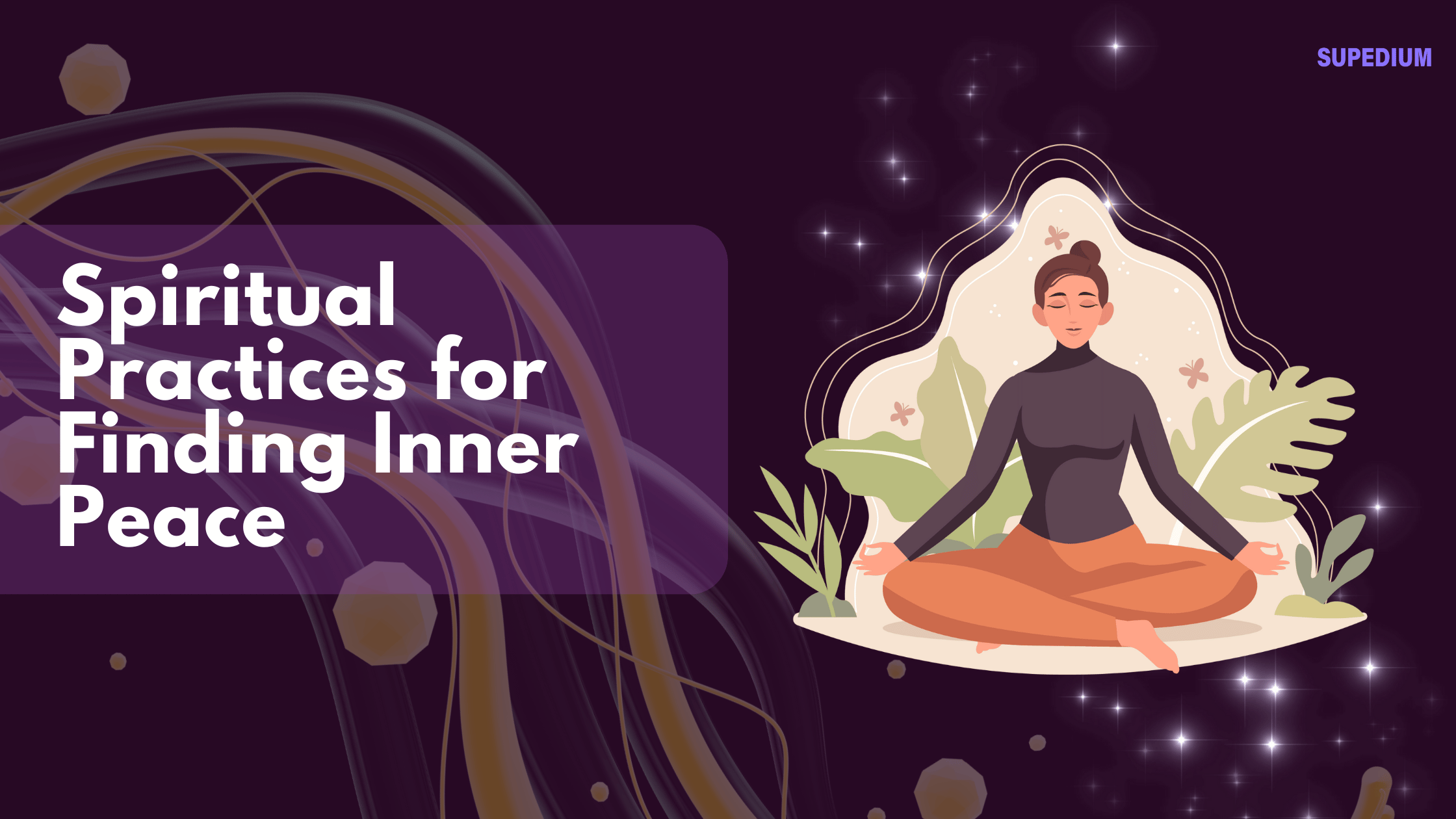Table of Contents
- 1 Introduction
- 2 Understanding Inner Peace
- 3 Spiritual Practices for Inner Peace
- 4 Integrating Spiritual Practices into Daily Life
- 5 Conclusion
![]()
Introduction
Inner peace is often described as a state of mental and emotional calmness, with a sense of balance and harmony. In today’s fast-paced world, the pursuit of inner peace has become increasingly essential, as stress and distractions can easily disrupt our mental well-being. Spiritual practices offer valuable tools for cultivating this tranquility, providing pathways to reconnect with ourselves and find solace amidst life’s challenges.
Understanding Inner Peace
Concept of Inner Peace in Various Spiritual Traditions
Inner peace is a central theme in many spiritual traditions. In Buddhism, it is linked to the cessation of suffering and the attainment of Nirvana through mindfulness and detachment from desires. Christianity emphasizes peace through faith and surrender to God’s will, while Hinduism often speaks of achieving Shanti (peace) through self-realization and meditation. Taoism highlights harmony with the Tao, the fundamental principle that underlies and unites all things.
Psychological and Emotional Benefits of Inner Peace
Achieving inner peace not only brings emotional stability but also enhances mental clarity, fosters resilience, and improves overall well-being. Individuals with a sense of inner peace often experience reduced anxiety, better relationships, and a greater capacity for joy. The journey towards inner peace can lead to deeper self-awareness and personal growth.
Signs of a Lack of Inner Peace
Signs of a lack of inner peace may include persistent anxiety, restlessness, difficulty concentrating, and feelings of overwhelm. Recognizing these signs is the first step toward addressing them and embarking on a journey to find tranquility.
Spiritual Practices for Inner Peace
Mindfulness and Meditation
Explanation of Mindfulness
Mindfulness involves being fully present in the moment, cultivating an awareness of thoughts, feelings, and sensations without judgment. This practice allows individuals to observe their inner experiences, reducing stress and enhancing emotional regulation.
Types of Meditation Practices
- Guided Meditation: Often led by a teacher or through recordings, this practice involves visualizing peaceful scenes or receiving gentle instructions.
- Transcendental Meditation: This technique uses a specific mantra to settle the mind into a profound state of rest and relaxation.
- Loving-Kindness Meditation: This practice focuses on generating feelings of compassion and love towards oneself and others, fostering a sense of connection and peace.
Benefits of Meditation for Calming the Mind
Regular meditation can significantly decrease stress levels, enhance emotional well-being, and promote a sense of calm. It encourages self-reflection and provides a sanctuary for the mind amidst external chaos.
Practical Tips for Incorporating Meditation into Daily Life
Start small by setting aside just five minutes each day. Create a designated space for meditation, free from distractions. Gradually increase the time as you become more comfortable with the practice.
Prayer and Intention Setting
Different Forms of Prayer
Prayer can take many forms, from structured religious practices to spontaneous expressions of gratitude. Engaging in prayer helps cultivate a connection to the divine and fosters a sense of hope.
Setting Intentions as a Spiritual Practice
Setting intentions involves clarifying your desires and aligning your actions with your values. This practice helps anchor your thoughts and encourages a proactive approach to life.
The Role of Gratitude in Prayer and Intention Setting
Incorporating gratitude into prayer enhances positivity and reinforces feelings of abundance, promoting inner peace.
Nature and Spiritual Connection
The Healing Power of Nature
Nature has a profound impact on our mental and emotional states. Studies show that spending time outdoors reduces stress, enhances mood, and fosters a sense of connection to something greater.
Practices to Connect with Nature
- Nature Walks: Engaging in mindful walks allows you to observe the beauty around you while promoting physical activity.
- Forest Bathing (Shinrin-yoku): This Japanese practice encourages immersing oneself in nature, promoting relaxation and mental clarity.
- Gardening: Tending to plants can be meditative, grounding you in the present moment and nurturing a sense of purpose.
The Significance of Natural Elements in Spiritual Practices
Incorporating elements of nature, such as stones, plants, and water, into spiritual practices can enhance feelings of peace and connection.
Yoga and Physical Movement
Overview of Yoga as a Spiritual Practice
Yoga combines physical movement, breath control, and meditation, creating a holistic practice that promotes both physical health and spiritual well-being.
Different Styles of Yoga for Peace
- Hatha Yoga: Focuses on physical postures and breath, suitable for all levels and promotes relaxation.
- Kundalini Yoga: Aims to awaken spiritual energy through dynamic movements, breathwork, and chanting.
Benefits of Physical Movement for Mental and Emotional Balance
Regular physical activity, such as yoga, releases endorphins, reduces stress, and promotes emotional resilience, contributing to a greater sense of inner peace.
Journaling and Self-Reflection
The Role of Journaling in Spiritual Growth
Journaling allows for introspection and can clarify thoughts and emotions, leading to greater self-awareness and understanding.
Different Types of Journaling Practices
- Gratitude Journaling: Focusing on what you are thankful for cultivates a positive mindset and enhances feelings of contentment.
- Reflective Journaling: Writing about your experiences and feelings can reveal patterns and insights that facilitate growth.
How Journaling Can Facilitate Self-Discovery and Inner Peace
Through journaling, individuals can explore their thoughts and feelings more deeply, often uncovering paths to peace and clarity.
Community and Connection
The Importance of Community in Spiritual Practices
Engaging with a community can provide support, encouragement, and shared experiences, which are essential for spiritual growth.
Group Meditations and Prayers
Participating in group practices fosters a sense of belonging and amplifies the collective energy of peace and intention.
Sharing Experiences and Support Through Spiritual Communities
Communities offer a safe space to share struggles and successes, reinforcing the journey toward inner peace.
Integrating Spiritual Practices into Daily Life
Creating a Personal Spiritual Routine
Establishing a consistent routine that includes various spiritual practices can help maintain inner peace. Identify what resonates with you and prioritize these practices in your daily schedule.
Overcoming Common Obstacles to Practice
- Time Management: Start with brief practices and gradually increase duration as you become more comfortable.
- Self-Doubt and Criticism: Approach your spiritual journey with compassion; remember that progress is a personal and unique experience.
Finding Balance Between Spiritual Practices and Daily Responsibilities
Integrating spiritual practices into daily life can enhance your overall well-being and provide moments of peace amid responsibilities.
Conclusion
Achieving inner peace is a journey that can be nurtured through various spiritual practices. From mindfulness and meditation to connecting with nature and engaging in community, these practices offer pathways to tranquility. Exploring what resonates personally can empower individuals to cultivate lasting inner peace and enrich their lives.
Share This





Be the first to comment